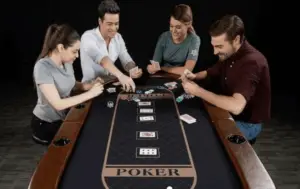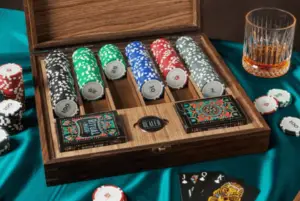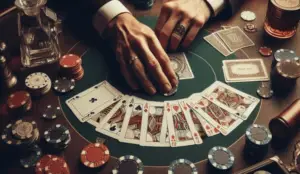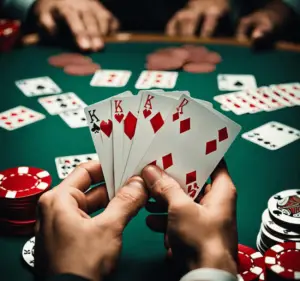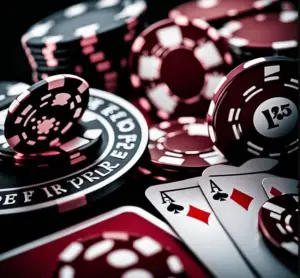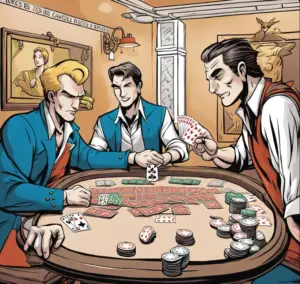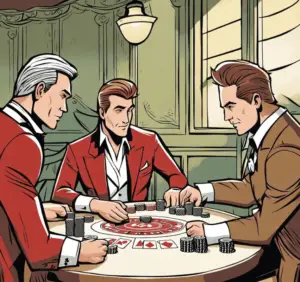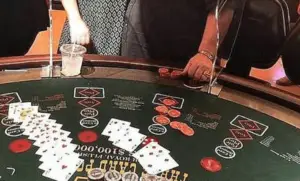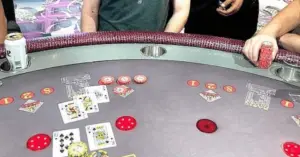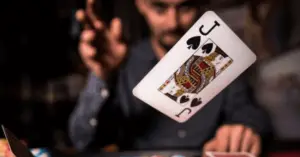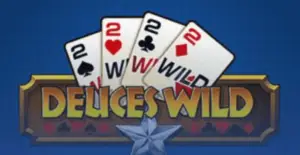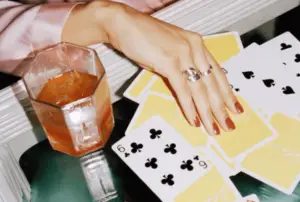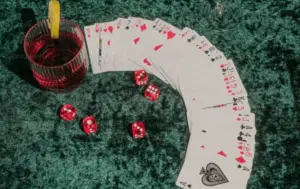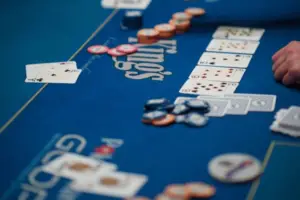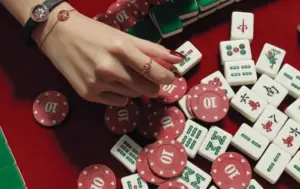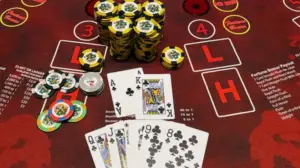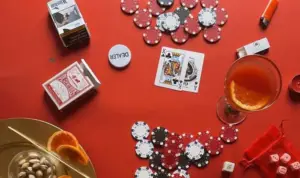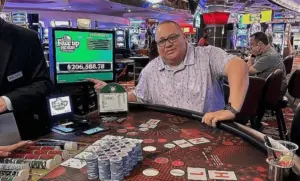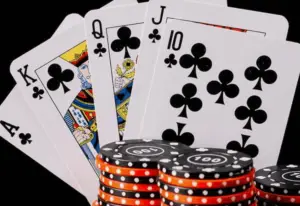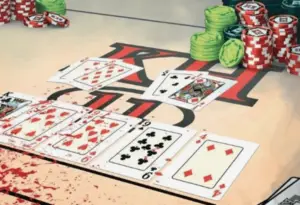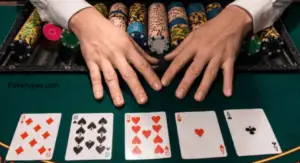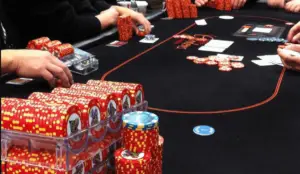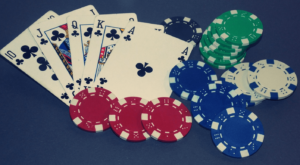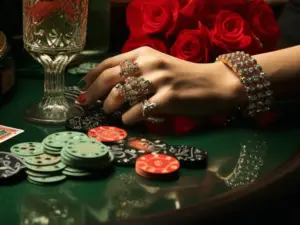In poker, blinds are mandatory bets placed by two players before cards are dealt. The small blind and big blind create an initial pot and drive action.
Blind play strategy is crucial because these positions are at a disadvantage, acting first post-flop. Many players make common mistakes from the blinds, like over-defending or playing too passively.
For example, in a $1/$2 game, the small blind posts $1 and the big blind $2. Upswing Poker notes that defending your big blind is important, as you only need 31% equity to call a 3x raise, compared to 40% on the button.
However, balance is key – defending too much can lead to chip loss. Understanding blinds is essential for both cash games and tournaments, where blinds increase over time to drive action. By mastering blind play, you’ll improve your overall poker strategy and avoid costly errors.
Fundamental Concepts for Blind Play
When playing from the blinds in poker, there are some key things to keep in mind. First, you gotta think about pot odds and equity realization. Pot odds tell you if it’s worth calling a bet based on how much is in the pot.
For example, if there’s $100 in the pot and you need to call $20, you’re getting 5-to-1 odds. That means you only need to win 1 in 6 times to break even.
But it’s not just about the odds – you also have to think about how likely you are to actually win if you hit your hand. That’s where equity realization comes in.
Next up is position and initiative. Being in position (acting last) is a big advantage in poker. When you’re in the big blind, you’re out of position for the whole hand.
But you do get to act last before the flop, which can help. Having the initiative (being the last aggressor) is also key. It lets you control the action and put pressure on your opponent.
Finally, you gotta consider ranges. In blind vs blind situations, ranges are way wider than normal. The small blind might open with any two cards, so the big blind can defend pretty wide too.
A good rule of thumb is to defend your big blind about 60% of the time against a small blind open. But you gotta adjust based on your opponent’s tendencies.
Remember, playing from the blinds is tough. You’re often out of position with a weak range. But if you think about these concepts, you can hold your own and maybe even come out ahead. Just don’t go crazy defending too wide – that’s a surefire way to bleed chips!
Small Blind Strategy
When you’re in the small blind, you’ve got some tough choices to make. Let’s break it down:
Completing vs raising: Some high-stakes players are now completing (just calling) from the small blind more often. This lets you play about 70% of hands instead of just 36% if you only raised. For example, with a hand like J♠4♦, completing might be better than raising, especially against short-stacked opponents.
Steal attempts: The small blind is a great spot for stealing. You should open-raise about 47.5% of hands, according to Upswing Poker. That’s a lot! But it makes sense because there’s only one opponent left, and they might fold too much. Just be careful not to go overboard.
3-betting ranges: When someone else raises first, you should usually 3-bet or fold from the small blind. This helps you avoid tricky spots out of position. Your 3-betting range should be pretty tight, though. Against a cutoff raise, you might 3-bet hands like AQs+, AKo, and 99+, while mixing in some bluffs like A5s or KJs.
Adjusting to opponents: This is key! If the big blind folds a lot, you can steal more often. If they’re aggressive, tighten up. For example, if they fold to steal 80% of the time, you can raise with almost any two cards! But if they’re a 3-bet happy maniac, you might want to play tighter and trap them more.
Remember, playing from the small blind is tough. You’re out of position and have already put money in the pot. But by using these strategies and paying attention to your opponents, you can turn this tricky spot into a profitable one. Just keep practicing and adjusting, and you’ll be crushing it from the small blind in no time!
Big Blind Defense Strategy
When it comes to big blind defense, you gotta be on your toes. Let’s break it down:
Defending ranges vs different positions: Your defense should change based on who’s raising. Against an early position raiser, you gotta be pickier.
They might have aces up their sleeve! But when the button raises, you can loosen up. Experts says you should defend about 70% of your hands against a button open.
That’s a lot! For example, you might fold J♠7♣ against an early raise, but call with it on the button.
Calling vs 3-betting: Sometimes you call, sometimes you raise back (3-bet). Against tight players, you might 3-bet more for value. But against loose cannons, you can 3-bet more as a bluff.
Ian Simpson from 888poker suggests 3-betting more against late position raises. A hand like A♠9♠ could be a call against early position, but a 3-bet against the button.
Postflop considerations: Playing out of position is tough, so plan ahead! Dara O’Kearney says to include some strong hands in your checking range to avoid being pushed around. Also, remember that ace-high is stronger in blind vs blind situations. On a dry board like 6♥6♣2♠, you might call a bet with A♥8♣.
Adjusting based on stack sizes: Your stack size matters big time. With a short stack (under 15 big blinds), you can’t rely on implied odds.
So, hands like 9♠2♠ become less playable. But with deep stacks, you can get creative. Upswing Poker notes that at 100 big blinds deep, you can defend wider, even with hands like 5♣3♣.
Remember, defending your big blind is all about adapting. Pay attention to who’s raising, how much they’re raising, and your stack size.
Don’t be afraid to mix it up – sometimes a sneaky call is better than a 3-bet. And always keep an eye on those pot odds. If you’re getting a good price to call, don’t be shy about seeing a flop with some funky holdings. Just be ready to fold if you miss!
Blind vs Blind Dynamics
When it comes to blind vs blind play, things get wild! Let’s break it down:
Small blind aggression: The small blind should be raising a ton – like, almost half the time! Upswing Poker says to open-raise about 47.5% of hands. That’s because there’s only one player left to beat. But watch out for tricky players who might fight back.
Big blind defense adjustments: The big blind needs to be ready for war. You can defend super wide here – maybe even 70% of hands against a small blind open.
Remember, you’ve already put money in the pot, so you’re getting a good price to call. Just be careful not to go overboard!
Heads-up considerations: This is where things get spicy. In heads-up play, ranges are super wide. The small blind might raise with any two cards, so the big blind has to adjust.
A good rule of thumb is to 3-bet or fold most of the time from the small blind. This helps you avoid tricky spots out of position.
Remember, ace-high is way stronger in blind vs blind spots. So don’t be afraid to call down with hands like A-8 on dry boards. And always keep an eye on stack sizes – they can change everything!
Blind vs blind play is all about adapting and being aggressive. Don’t be scared to mix it up and put pressure on your opponent. Just be ready for some wild swings!
Tournament-Specific Blind Play
When it comes to tournament poker, playing from the blinds gets tricky. Let’s break it down:
ICM considerations: ICM (Independent Chip Model) is a big deal in tournaments. It means that losing chips hurts more than winning chips helps.
For example, if you’re on the bubble with a medium stack, you might fold AK to a shove from a big stack. Sounds crazy, right?
But it’s often the right play because busting out would cost you more than calling and winning would gain you.
Short stack adjustments: When you’re short-stacked, you gotta get aggressive. Upswing Poker says with less than 15 big blinds, you should be shoving or folding most hands.
For instance, if you’ve got 10 big blinds on the button, you might shove with any ace, any pair, or even hands like K9 suited.
Ante effects on strategy: Antes change everything! They make the pot bigger, so you can open more hands. BlackRain79 says you should open about 40% more hands with antes in play.
For example, from the cutoff without antes, you might open 26% of hands. With antes, that jumps to about 36%!Remember, tournament poker is all about adapting. Pay attention to stack sizes, position, and those pesky antes. And don’t forget about ICM – it might save your tournament life!
Cash Game Blind Play
When it comes to cash game blind play, there’s a lot to think about. Let’s break it down:
Rake considerations: Rake is a big deal in cash games. It’s the money the casino takes from each pot. In high-rake games, you gotta play tighter.
For example, in a $1/$2 game with a $5 rake, you might only defend your big blind with 35% of hands instead of 50%. That’s because the rake eats into your profits.
Deep stack dynamics: When you’re playing with deep stacks (like 200 big blinds or more), things change. You can play more suited connectors because they can make big hands.
But be careful! Poker players say to lean towards hands that can make the nuts. You don’t wanna get stuck with the second-best hand when there’s a ton of money in the pot.
Multiway pot strategy: In multiway pots, you gotta tighten up. PokerPro says bluffing is way less effective here. Instead, focus on strong value bets.
For example, in a 3-way pot, you might bet with the top pair good kicker, but check with the middle pair. Remember, in multiway pots, your opponents don’t have to defend as wide.
Cash game blind play is all about adapting. Keep an eye on the rake, stack sizes, and how many players are in the pot. And don’t forget – position is king! The player acting last has a big advantage, so use it wisely when you’re in the big blind.
Advanced Blind Play Concepts
Let’s dive into some advanced blind play concepts:
Blind stealing frequencies: When you’re on the button, you should be stealing the blinds a ton! Upswing Poker says to open about 60% of hands.
That’s way more than from other positions. Why? Because you’ve got the position and only two players to get through. But watch out – if the blinds start fighting back, you might need to tighten up.
3-bet bluffing from the blinds: This is where things get spicy. From the small blind, you should 3-bet about 14% of hands against a button open.
But here’s the kicker – not all of those are for value! Mix in some bluffs with hands like A5 suited or KJ suited. These hands play well if called, but can also win right away.
Check-raising strategies: When you’re in the big blind, check-raising is a powerful weapon. On dry boards like K♠7♣2♦, you might check-raise with strong hands like sets, but also some bluffs.
PokerCoaching suggests using a small size (about 2.5x the bet) with a wide range. This puts your opponent in a tough spot.
Blind vs blind 3-bet/4-bet dynamics: This is where the real fireworks happen! In blind vs blind pots, ranges are super wide. The small blind might open with any two cards, so the big blind can 3-bet light. But here’s the twist – the small blind can then 4-bet bluff! Tournament Poker Edge says to pick hands that can stand a 5-bet shove, like A5s or small pairs.
Remember, these advanced plays are like a dance. You gotta adjust based on your opponent. If they’re folding too much, bluff more. If they’re calling everything, tighten up those value ranges. And always keep an eye on stack sizes – they change everything in tournament play!
Common Mistakes to Avoid
When playing from the blinds, there are some common mistakes you gotta watch out for. Let’s break ’em down:
Over-defending: It’s tempting to call a lot from the big blind because you’ve already put money in the pot. But don’t go overboard! Poker pros says you should defend about 40-50% of hands against a button open.
For example, you might call with K♠7♠ against a button raise, but fold it to an under-the-gun open. Remember, playing too many hands out of position can be a recipe for disaster!
Playing too passively post-flop: Once you’ve called from the blinds, don’t just check-fold everything! PokerPro suggests mixing in some check raises, even with medium-strength hands.
On a flop like A♥7♣2♦, you might check-raise with a hand like 7♠6♠ to put pressure on your opponent. Being too passive makes you an easy target for aggressive players.
Ignoring opponent tendencies: Pay attention to how your opponents play! If someone’s raising every hand from the button, you can defend wider.
But if a tight player opens from early position, tighten up your range. BlackRain79 says adjusting to your opponents is key to winning from the blinds.
Failing to adjust based on stack sizes: Your stack size changes everything! With a short stack (less than 15 big blinds), you should be shoving or folding most hands.
But with deep stacks, you can get creative. Tournament Poker Edge suggests that with 100 big blinds, you can call with hands like 9♣2♣ from the big blind, hoping to flop a monster.
Remember, playing from the blinds is tough. You’re out of position and often have a weak range. But by avoiding these mistakes, you can minimize your losses and maybe even turn a profit.
Just keep practicing and adjusting your strategy based on the situation. And don’t forget – sometimes the best play from the blinds is to fold and live to fight another hand!
Conclusion
The art of blind play is crucial in poker. It’s where you’ll play a ton of hands, so even small improvements can make a big difference. Poker pros says good blind play can boost your win rate by 2-3 big blinds per 100 hands.
That’s huge! Keep studying and practicing. Try out new strategies in low-stakes games before moving up. Remember, poker’s always changing, so stay on your toes.
Watch how the pros play from the blinds and adapt their tricks to your game. With solid blind play, you’ll be a tougher opponent and see your profits grow. So get out there and crush it from the blinds!



